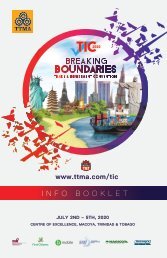TIC 2018 Manufactuer E-MAG
You also want an ePaper? Increase the reach of your titles
YUMPU automatically turns print PDFs into web optimized ePapers that Google loves.
Grenada<br />
The tiny Caribbean island of Grenada is one of the smallest<br />
independent countries in the western hemisphere.<br />
Known as the Spice Island, it is the world’s second-largest<br />
producer of nutmeg after Indonesia and a significant producer<br />
of mace, cinnamon, ginger and cloves. It also boasts beautiful<br />
scenery with fertile valleys, rainforests and mountain lakes and its<br />
tropical climate and excellent beaches are a big draw for tourists.<br />
• Population 105,000<br />
• Area 344 sq km (133 sq miles)<br />
• Major languages English (official), French patois<br />
• Major religion Christianity<br />
• Life expectancy 74 years (men), 78 years (women)<br />
• Currency East Caribbean dollar<br />
• UN, World Bank<br />
The Gross Domestic Product (GDP) in Grenada was worth 1.12<br />
billion US dollars in 2017. The GDP value of Grenada represents<br />
less than 0.01 percent of the world economy. GDP in Grenada<br />
averaged 0.47 USD Billion from 1977 until 2017, reaching an alltime<br />
high of 1.12 USD Billion in 2017 and a record low of 0.07<br />
USD Billion in 1977.<br />
PANAMA<br />
• Population: 3.93 million (UN, 2016)<br />
• Capital: Panama City<br />
• Area: 75,517 sq km (29,157 sq miles)<br />
• Major languages: Spanish, English<br />
• Major religion: Christianity<br />
• Life expectancy: 74 years (men), 79 years (women) (UN<br />
2013)<br />
• Monetary unit: 1 balboa = 100 cents<br />
• Main exports: Bananas, fish, shrimp, petroleum products<br />
• GNI per capita: US$ 10,700 (World Bank, 2012-13)<br />
• Internet domain: .pa<br />
• International dialling code: +507<br />
Panama is a strong economic powerhouse that is supported by<br />
the services provided to the Panama Canal and the country’s<br />
banking system. Services include operating the Panama Canal,<br />
logistics, banking, the Colon Free Zone, insurance, container<br />
ports, flagship registry, and tourism. Economic growth will be<br />
bolstered by the Panama Canal expansion project that began<br />
in 2007 and is estimated to be completed by 2015 at a cost<br />
of $5.3 billion .The expansion project will more than double<br />
the Canal’s capacity, enabling it to accommodate ships that are<br />
too large to traverse the existing canal. The country’s average<br />
growth of 8.4% between 2007 and 2013 has made it one of the<br />
fastest growing economies in Latin America and one of the more<br />
sound economies (the country was able to successfully weather<br />
the global economic crisis which began in 2008). Indeed, the<br />
Republic of Panama remains a natural point of transit-be it<br />
money through its national financial centre , goods through its<br />
canal or people through its expanding airport.<br />
Dominican Republic<br />
The Dominican Republic is a middle-income country, with<br />
the largest economy in Central America and the Caribbean<br />
(WorldBank) Once ruled by Spain, the Dominican Republic shares<br />
the island of Hispaniola with Haiti, a former French colony. The<br />
Caribbean nation is a major tourist destination. This, coupled<br />
with free-trade zones, has become the country’s major employer<br />
and key sources of revenue, replacing dependence on sugar,<br />
coffee and other exports.<br />
In recent years the service sector has overtaken agriculture as the<br />
economy’s largest employer, due to growth in telecommunications,<br />
tourism, and free trade zones. The economy is highly dependent<br />
upon the United States, the destination for approximately half of<br />
exports. Remittances from the US amount to about 5% of GDP,<br />
equivalent to about a third of exports and two-thirds of tourism<br />
receipts. According to Forbes (2014), the Dominican Republic<br />
(DR), suffers from marked income inequality; the poorest half<br />
of the population receives less than one-fifth of GDP, while the<br />
richest 10% enjoys nearly 40% of GDP. High unemployment and<br />
underemployment remains a long-term challenge.<br />
• Capital: Santo Domingo<br />
• Major Languages: Spanish<br />
• Monetary Unit: 1 Dominican peso = 100 centavos<br />
• GNI Per Capita: US$ 5,700 (World bank 2014)<br />
• Population: 10.40 Million (World Bank 2013)<br />
• Area: 48,072 sq km (18,696 sq miles)<br />
• Life expectancy: 71 years (men), 77 years (women) (UN)<br />
• Main exports: Ferronickel, sugar, gold, silver, coffee, cocoa,<br />
tobacco, meats<br />
Haiti<br />
Haiti became the world’s first black-led republic and the first<br />
independent Caribbean state when it threw off French colonial<br />
control and slavery in the early 19th century.<br />
100% Juices<br />
No added sugar<br />
18 19
















